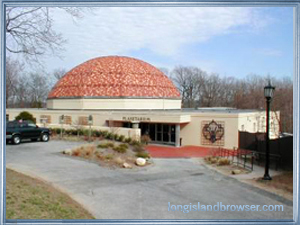 Vanderbilt Museum Planetarium
Vanderbilt Museum Planetarium180 Little Neck Road
Centerport, NY 11721
phone: 631-854-5555
www.vanderbiltmuseum.org
The Vanderbilt Planetarium opened in 1971 on the grounds of the Vanderbilt estate, and it is the largest facility of its kind on Long Island. The Planetarium's purpose is to provide visitors with information about the nighttime sky. The Planetarium's main feature is the domed, 60-foot Sky Theater. The theater's Goto star projector can display the sun, moon, stars and planets. It also recreates celestial events during our various Sky Shows.
The Astronomical Society of Long Island holds its monthly observing session at the Vanderbilt Planetarium. Their observing session is on the Wednesday evening closest to the New Moon. ASLI is one of the most active groups in the New York Metropolitan Area. We are a group of dedicated amateur astronomers and telescope makers with a passion for our hobby, and a willingness to share our knowledge and excitement of the hobby with others, both experienced, and those who may have just discovered the hobby.
MEETINGS: EVERY Wednesday Night
MEETING TIME: 8:30 PM
LOCATION: The Vanderbilt Planetarium, Centerport, NY August 24 - The Science Museum of London - by Helen McEntire. Our esteemed president went "across the pond" and while there visited the Science Museum of London. She took lots of pictures which she will share with us in her talk. She spent time in "The Exploring Space Gallery" which contains a host of rockets, satellites, space probes and landers. She also visited the brand-new "Atmosphere" gallery - a fresh and exciting way to make sense of the climate - the science of how it works, what it's doing now, and what it might do next.
August 31 - Introduction to a Fantastic Discovery of the Radio Universe - Dr. Ron Milione, Senior Systems Engineer, DasNet Corporation, Bohemia, NY. Radio waves were first detected from space in the 1930’s but few scientists took the discovery seriously. After WWII scientists began to use Radar to investigate signals coming from space. Since that time Astronomical observations at radio wavelengths have played a key role in the discovery and study of certain classes of astronomical objects. Dr. Milione will be giving us really interesting and thorough introduction to radio astronomy.
No comments:
Post a Comment
Thank you for your comments!